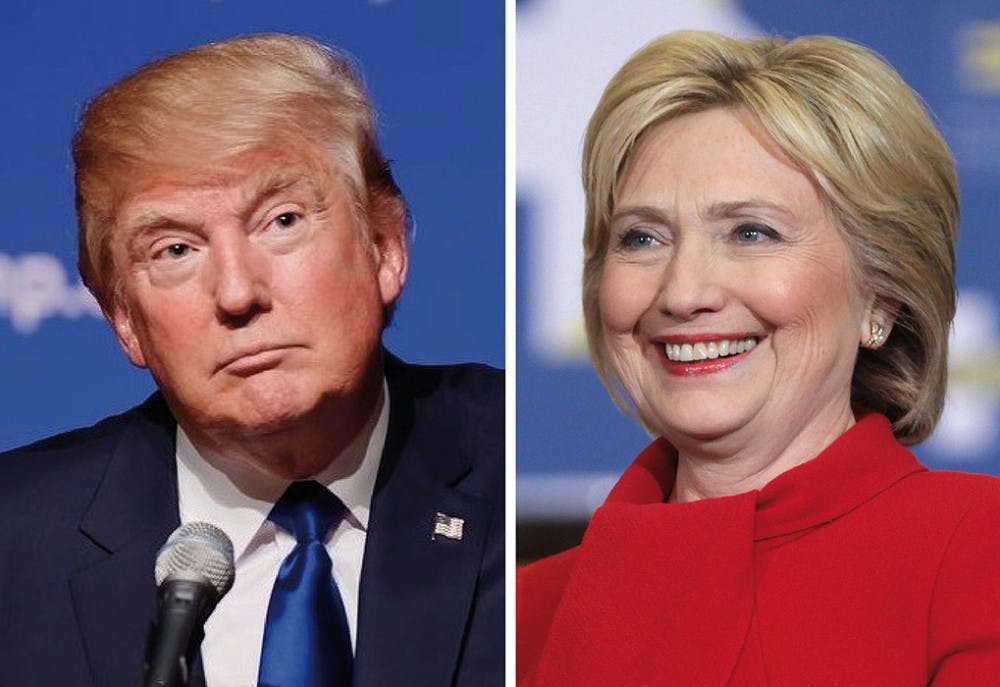For many students, the upcoming November election will be the first presidential election in which they are able to vote. As a result, students may be considering what stances two candidates — Democratic nominee Hillary Clinton and Republican nominee Donald Trump — are taking on student debt and the cost of college.
Both Clinton and Trump have said they want to reform higher education and make higher education more accessible, but each has a different plan to accomplish that goal.
Trump has said he wants to see a reduction in college tuitions, stating he will “work with Congress on reforms to ensure universities are making a good faith effort to reduce the cost of college and student debt.”
In a speech last Thursday in Columbus, Ohio, Trump revealed more details of his higher education plan.
Trump proposed his own income-based debt repayment plan for borrowers paying back student loans, which would cap the amount of repayment at 12.5 percent of their income and would also forgive debts after 15 years.
Trump said he hopes this will be done in exchange for federal tax breaks and tax dollars.
Clinton’s college affordability plan, named the “New College Compact,” aims to entirely eliminate tuition fees of state-funded universities for families earning up to $125,000 a year, which would cover over 80 percent of families by the year 2021, according to Clinton’s website.
The New College Compact also aims to help pay for non-tuition expenses by protecting and restoring year-round Pell Grant funding.
Clinton’s plan also includes investment in historically black colleges and universities and minority-serving institutions with the aim of helping “deserving students” to “also benefit from the lower cost of college.”
These policies will be paid for by “closing tax loopholes and expenditures for the most fortunate,” according to Clinton’s website. She also expects states to contribute to the plan through “reinvestment and reform.”
Clinton’s plan expects students to contribute financially to their education as well, by “working at least 10 hours a week.”
Carah Ong-Whaley, a lecturer in the Politics department, said Trump’s plans for dealing with student debt were more generous than Clinton’s — whose plan would cap debt repayment at 10 percent and forgive debt after 20 years — and could be part of efforts to appeal to millennials.
Trump has also criticized universities with large endowments for not contributing enough to making college affordable for students of all socioeconomic backgrounds.
In last Thursday’s speech, Trump considered ending tax exemptions for high-endowment universities and increasing scrutiny on high private endowments.
“Some schools are paying more to hedge funds and private-equity managers than they are spending on tuition and tuition assistance, while taxpayers are guaranteeing hundreds of billions of dollars of student loans to pay for rising tuition costs,” Trump said. “We want universities to spend their endowments on their students, not themselves.”
He also said he aims to reduce “administrative bloat,” which he claims forces universities to pay senseless costs which could be spent to help students.
Ong-Whaley said the composition of Congress will greatly affect what kinds of policies can be implemented.
“Will compromise and reform efforts even be a possibility given that we are likely to have fewer moderate members of Congress — from either party — elected?” Ong-Whaley said in an email statement.
She also said neither candidate has given detailed plans to help with students’ college performances, preparing students for college or addressing the rising underlying costs of college.
James Todd, a lecturer in the Politics department, said Trump and Clinton’s policy proposals present “more questions than there are answers.”
One of the key issues the proposals raise is how increased affordability will affect classroom size.
“If you suddenly have thousands of people show up, how are you going to teach them all?” Todd said. “Who is going to pay to build the classrooms to support them?”
Part of the difficulty of determining exactly what will and can happen comes from the lack of precedent, Todd said.
“The whole question of education in the federal government is a fairly new subject in our history,” Todd said. “It wasn’t thought of as a major role — it was thought of as something for local communities to deal with.”
For University students, this issue hits particularly close to home. The median federal debt of University undergraduate borrowers who graduate comes in at nearly $20,000, according to the Obama administration’s College Scorecard.
Ajay Trivedi, a fifth-year College student, said affordable college is the most critical issue for him looking at the November election.
“I want [the candidates] to focus on tuition and the cost of higher education,” Trivedi said. “Reforming the way debts are handled and the way they’re structured is incredibly important for the next generation of students. College, without change, will continue to become more selective and expensive.”
This issue is exceedingly important for those from low socioeconomic backgrounds.
Emily Dennan, a third-year College student and a co-coordinating chair for United for Undergraduate Socioeconomic Diversity, said policies which help students afford college in the first place are more important than debt forgiveness.
“Low-income students won’t even think about applying because it’s expensive,” Dennan said, “so they won’t even attempt to apply because they think it’s too expensive regardless of availability of aid.”
While a reduced cost of public education and debt forgiveness are ideal outcomes of the election for students like Trivedi and Dennan, it is difficult to foresee how either candidate’s higher education policies will play out in 2017.







